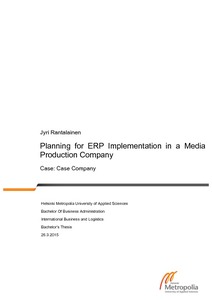Planning for ERP Implementation in a Media Production Company : Case: Case Company
Rantalainen, Jyri (2015)
Rantalainen, Jyri
Metropolia Ammattikorkeakoulu
2015
All rights reserved
Julkaisun pysyvä osoite on
https://urn.fi/URN:NBN:fi:amk-201504224746
https://urn.fi/URN:NBN:fi:amk-201504224746
Tiivistelmä
This thesis analyses enterprise resource planning (ERP) systems and the challenges and benefits of implementing them in companies. The thesis consists of theory of ERP systems with an analysis of the history of ERP systems. This provides some necessary background information that is useful when considering ERP implementation. It also focuses on the phases and focus points of ERP implementation to provide readers with an analysis of the efforts needed to start an ERP implementation project.
The case company of this thesis is a small-scale media production company in Finland, which focuses on the production of 3D images and graphics for advertisements, movies and television series. The objective of the case study is to analyse the challenges and possibilities that the case company faces in the project of implementing an ERP system in their company. The target of the case study is to provide the necessary groundwork on the very initial stages of the ERP implementation process. This serves as a practical challenge to provide results for the case company as well as an example of for the readers of ERP implementation analysis in a specific company working in the media industry.
The target objective of this thesis is to provide the case company with a possible solution to enhance their current processes. This has been done through the research of theory to provide necessary theoretical information of ERP implementation. The case study uses the information of the research and research gained through the author's experience of working in the case company (8.11.2013-8.5.2014) and interviews conducted after the working period ended. The goal is to provide an analysis of a very specific small-scale company operating in the media industry and to determine the challenges and opportunities that such a company could have with ERP implementation.
As a result of this thesis the case company is still in the initial planning stages of ERP implementation. The company has undergone major changes after the author's placement period ended in the company and therefore the ERP implementation project has lost its place in the company's priorities. However the research and analysis done in this thesis has provided the company with possible solutions and analysis of the risks and opportunities that it can use when ERP implementation becomes a higher priority again.
The case company of this thesis is a small-scale media production company in Finland, which focuses on the production of 3D images and graphics for advertisements, movies and television series. The objective of the case study is to analyse the challenges and possibilities that the case company faces in the project of implementing an ERP system in their company. The target of the case study is to provide the necessary groundwork on the very initial stages of the ERP implementation process. This serves as a practical challenge to provide results for the case company as well as an example of for the readers of ERP implementation analysis in a specific company working in the media industry.
The target objective of this thesis is to provide the case company with a possible solution to enhance their current processes. This has been done through the research of theory to provide necessary theoretical information of ERP implementation. The case study uses the information of the research and research gained through the author's experience of working in the case company (8.11.2013-8.5.2014) and interviews conducted after the working period ended. The goal is to provide an analysis of a very specific small-scale company operating in the media industry and to determine the challenges and opportunities that such a company could have with ERP implementation.
As a result of this thesis the case company is still in the initial planning stages of ERP implementation. The company has undergone major changes after the author's placement period ended in the company and therefore the ERP implementation project has lost its place in the company's priorities. However the research and analysis done in this thesis has provided the company with possible solutions and analysis of the risks and opportunities that it can use when ERP implementation becomes a higher priority again.
